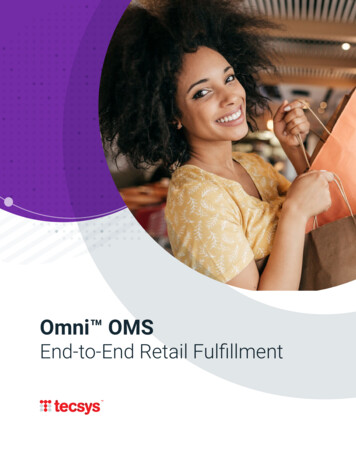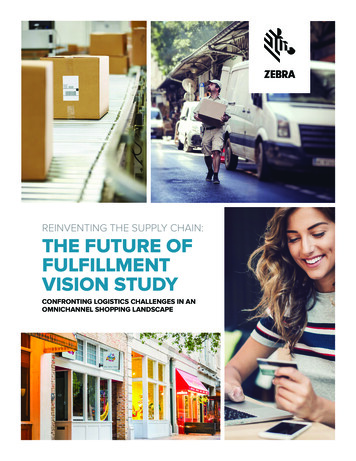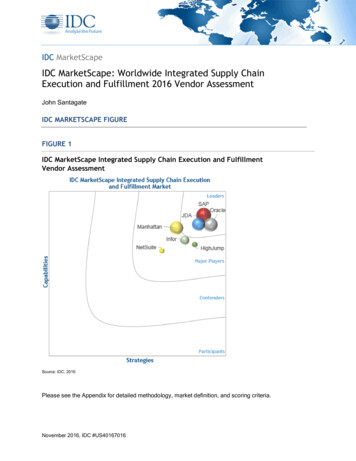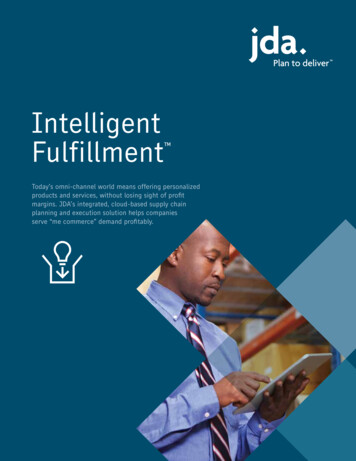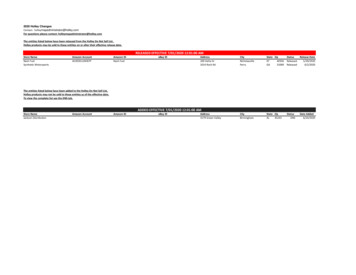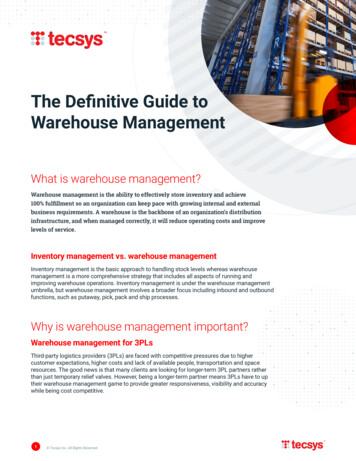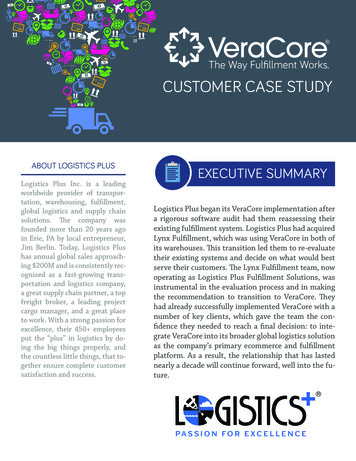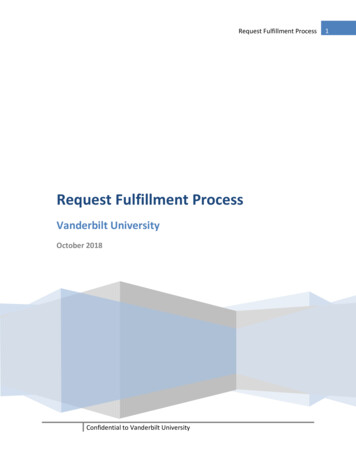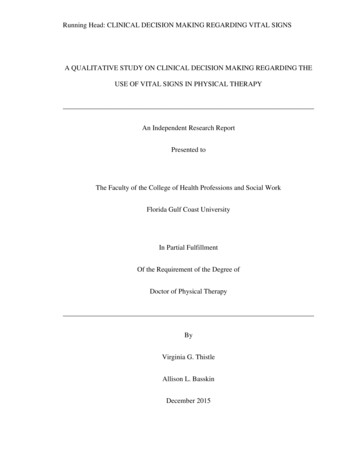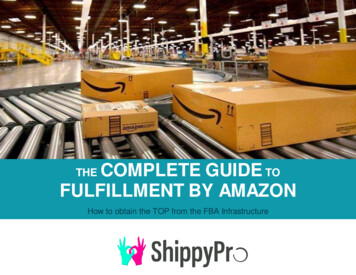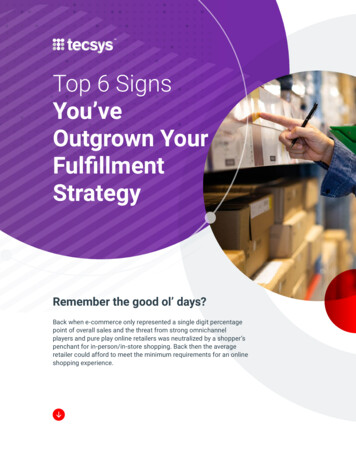
Transcription
Top 6 SignsYou’veOutgrown YourFulfillmentStrategyRemember the good ol’ days?Back when e-commerce only represented a single digit percentagepoint of overall sales and the threat from strong omnichannelplayers and pure play online retailers was neutralized by a shopper’spenchant for in-person/in-store shopping. Back then the averageretailer could afford to meet the minimum requirements for an onlineshopping experience.
It didn’t matter how long it took to get an order to thecustomer, as long as it got there — eventually — seemedgood enough. And that’s if it even got there and wasn’tcancelled for lack of inventory.Wrong size, wrong color? No problem, just find an oldbox, print out a mailing label from an email, cut out saidlabel, tape it to the box and then find time to go to thepost office to have it returned.Pickup in-store you say? Great! Place your order andwe’ll see you in a week.Ah the good ol’ days.Customers expect more and more (and more)The new reality is that shoppers have come to expect more from retailers because of the Amazon effect (fast, freeshipping) and the omnichannel effect (retailers setting a high standard for omnichannel experiences).Network-wide inventory visibilityRegular notifications(by text and/or email)Seamless and convenient BOPAC (buy online pickup at curb)Cross-channel returnsBOPIS (buy online pickup in-store)within a two-hour windowOrder consolidationSame-day deliveryError-free ordersThe list goes on and these are no longer an aspiration, they’re an expectation.E-COMMERCE10 YEARS AGOE-COMMERCENOW5.1%More than 10 years ago, e-commerce accountedfor 5.1% of total retail purchases. Online sales nowaccount for 21%, a striking jump from 16% in 2019.121%2 Tecsys Inc. All Rights Reserved.With e-commerce’s share of total retail sales atits highest percentage ever — and likely to stay atthese higher levels due to shoppers’ acclimationto the omnichannel experience — retailers need tomeet these expectations or lose ground to moreomni-savvy competitors.E-commerce as a percentage of total global retailsales will also continue to grow over the nextfive years.2
Costs are going upWe can see the law of supply and demand is in full force when it comes to the cost offulfillment and delivery. The increase of e-commerce orders and home deliveries hascaused major courier fee increases.According to a CNBC article regarding a report by Jefferies, “The recent growthin shipping costs has been fueled by the surge in e-commerce penetration,which has created a significant supply/demand imbalance and left carrierscapacity constrained. Holiday surcharges that shipping carriers like FedEx andUPS implemented to prepare for the influx of orders aren’t going away. Thesesurcharges will likely become the new normal moving forward, in addition tothe 5% to 6% annual increases that are usually seen.3”The alternative, using third-party delivery apps also comes at both a financial andbrand cost. From a financial perspective, third-party delivery services can be costprohibitive, just ask the restaurant industry.CNN Business recently reported, “Restaurant operators complain that third-partydelivery providers like Seamless, DoorDash and Uber Eats are prohibitivelyexpensive. These platforms offer a way for customers to order from localrestaurants, process restaurant payments and provide contract drivers to pickmeals up from restaurants and deliver them to customers. For these services,they often charge restaurants around 30% per order. But profit margins inthe restaurant industry are often razor-thin, so these fees can wipe out therestaurant’s profits or put them in the red.4”From a brand perspective, once an order is picked up by a third-party delivery service,the delivery driver is pretty much in control of your brand experience from that pointon. Do you want your last mile customer experience to be in the hands of someonewith no connection to your brand?Whether you stay with a courier company or venture into uncharted waters witha third-party app, online order margins are already thin and these uncontrollableincreases in delivery costs can easily render online orders unprofitable.From a fulfillment perspective, large warehouses (notoriously difficult to staff andwith high overheads) are also contributing to the increase in order costs. Retailersupply chains are wired for store replenishment in cases and pallets, not pickingdirect-to-customer parcels (or “eaches” in warehouse talk). As a result, while it’spossible to run a DC or warehouse system meant for wholesale order fulfillmentto fulfill e-commerce orders, it sure isn’t optimal. And that’s if a retailer even has asystem in place and isn’t running their operation using spreadsheets or worse, theirpaper packing slips off the ERP.It’s not all doom and gloomRetail sales are growing. Online sales and store sales are growing. The customerdemand is there. The big question is whether you have the ability to meet thatdemand? The answer will come down to your willingness to adopt new strategies,technologies and processes to reshape your fulfillment strategy and succeed in thenext phase of retail.3 Tecsys Inc. All Rights Reserved.Do you want your last milecustomer experience to bein the hands of someonewith no connection to yourbrand?Large warehouses(notoriously difficult to staffand with high overheads)are also contributing to theincrease in order costs.
To help retailers identify what stepsthey need to take to transform theirfulfillment, we’ve created six signsto help you discover whether you’veoutgrown your fulfillment strategy:Sign 1.The more staff you add to your distribution center, the lower the order output.Sure, this seems counterintuitive, but it happens. The reason? There’s no system in place that enablesefficient pick and pack through process mapping and efficient workflows.Sign 2.Your current WMS is a bottleneck for e-commerce order fulfillment.This also seems counterintuitive, but it also happens! The reason? The WMS was not designed fore-commerce fulfillment and is unable to drive efficiency in the warehouse.Sign 3.Your shipping/fulfillment costs are too high.Shipping from store can potentially save money by reducing the delivery distance from the fulfillment centerto the customer. Fulfilling (and shipping) from store can add even more savings because the merchandisedoesn’t need to be routed from somewhere else (e.g., a DC). Perhaps micro-fulfillment is in the cards.4 Tecsys Inc. All Rights Reserved.
Sign 4.It takes too long to get your orders out.Your fulfillment center (whether it’s a DC or store) is not optimized and could benefit from advancedprocesses like batch and wave picking, mechanized fulfillment or perhaps even warehouse automation.Sign 5.Your order fulfillment is not accurate enough.You need a system that ensures your staff are choosing the right items. Advanced WMS tools such as RFbased barcode scanning, pick-to-light or pick-to-voice are designed for that.Sign 6.You need to do something about returns.Returns: the scourge of e-commerce. The answer: get them in, get them sorted, put them back on the shelfand sell them again. A retail-oriented WMS will make short work of this.Do you relate to any of these signs?If any of the above statements can be heard in the boardroom, hallways or Zoom calls of yourorganization, the time has come to transform your fulfillment.Speak to a retail fulfillment expertSourcesFareeha, Ali. A decade in review: Ecommerce sales vs. retail sales 2007-2020. Digital Commerce 360. January 29, 2021.The Future of Ecommerce Report 2021. Shopify.3Tsai, Katie. Online shipping costs expected to increase further into the pandemic. CNBC. February, 18, 2021.4Wiener-Bronner, Danielle. Some restaurants hate delivery apps like Grubhub and Uber Eats. So they’re seeking out alternatives. CNN Business.December 1, 2020.12For more information about Tecsyscontact us at 800-922-8649 or info@tecsys.com5 Tecsys Inc. All Rights Reserved.
e-commerce fulfillment and is unable to drive efficiency in the warehouse. Sign 3. Your shipping/fulfillment costs are too high. Shipping from store can potentially save money by reducing the delivery distance from the fulfillment center to the customer. Fulfilling (and shipping) from store can add even more savings because the merchandise
